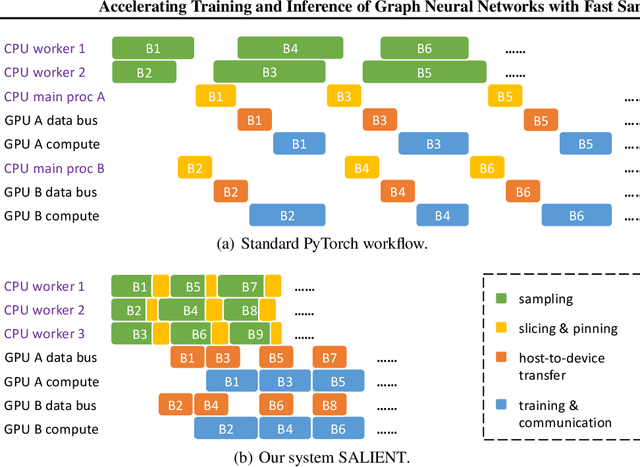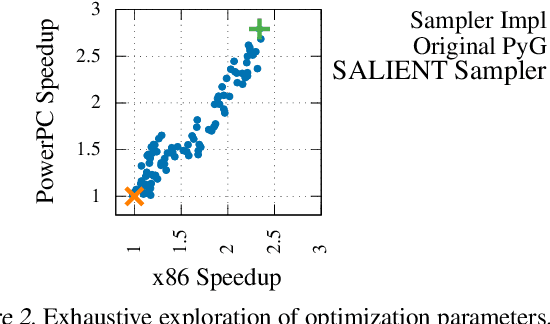Tao B. Schardl
Communication-Efficient Graph Neural Networks with Probabilistic Neighborhood Expansion Analysis and Caching
May 04, 2023Abstract:Training and inference with graph neural networks (GNNs) on massive graphs has been actively studied since the inception of GNNs, owing to the widespread use and success of GNNs in applications such as recommendation systems and financial forensics. This paper is concerned with minibatch training and inference with GNNs that employ node-wise sampling in distributed settings, where the necessary partitioning of vertex features across distributed storage causes feature communication to become a major bottleneck that hampers scalability. To significantly reduce the communication volume without compromising prediction accuracy, we propose a policy for caching data associated with frequently accessed vertices in remote partitions. The proposed policy is based on an analysis of vertex-wise inclusion probabilities (VIP) during multi-hop neighborhood sampling, which may expand the neighborhood far beyond the partition boundaries of the graph. VIP analysis not only enables the elimination of the communication bottleneck, but it also offers a means to organize in-memory data by prioritizing GPU storage for the most frequently accessed vertex features. We present SALIENT++, which extends the prior state-of-the-art SALIENT system to work with partitioned feature data and leverages the VIP-driven caching policy. SALIENT++ retains the local training efficiency and scalability of SALIENT by using a deep pipeline and drastically reducing communication volume while consuming only a fraction of the storage required by SALIENT. We provide experimental results with the Open Graph Benchmark data sets and demonstrate that training a 3-layer GraphSAGE model with SALIENT++ on 8 single-GPU machines is 7.1 faster than with SALIENT on 1 single-GPU machine, and 12.7 faster than with DistDGL on 8 single-GPU machines.
Accelerating Training and Inference of Graph Neural Networks with Fast Sampling and Pipelining
Oct 16, 2021



Abstract:Improving the training and inference performance of graph neural networks (GNNs) is faced with a challenge uncommon in general neural networks: creating mini-batches requires a lot of computation and data movement due to the exponential growth of multi-hop graph neighborhoods along network layers. Such a unique challenge gives rise to a diverse set of system design choices. We argue in favor of performing mini-batch training with neighborhood sampling in a distributed multi-GPU environment, under which we identify major performance bottlenecks hitherto under-explored by developers: mini-batch preparation and transfer. We present a sequence of improvements to mitigate these bottlenecks, including a performance-engineered neighborhood sampler, a shared-memory parallelization strategy, and the pipelining of batch transfer with GPU computation. We also conduct an empirical analysis that supports the use of sampling for inference, showing that test accuracies are not materially compromised. Such an observation unifies training and inference, simplifying model implementation. We report comprehensive experimental results with several benchmark data sets and GNN architectures, including a demonstration that, for the ogbn-papers100M data set, our system SALIENT achieves a speedup of 3x over a standard PyTorch-Geometric implementation with a single GPU and a further 8x parallel speedup with 16 GPUs. Therein, training a 3-layer GraphSAGE model with sampling fanout (15, 10, 5) takes 2.0 seconds per epoch and inference with fanout (20, 20, 20) takes 2.4 seconds, attaining test accuracy 64.58%.
TapirXLA: Embedding Fork-Join Parallelism into the XLA Compiler in TensorFlow Using Tapir
Aug 29, 2019



Abstract:This work introduces TapirXLA, a replacement for TensorFlow's XLA compiler that embeds recursive fork-join parallelism into XLA's low-level representation of code. Machine-learning applications rely on efficient parallel processing to achieve performance, and they employ a variety of technologies to improve performance, including compiler technology. But compilers in machine-learning frameworks lack a deep understanding of parallelism, causing them to lose performance by missing optimizations on parallel computation. This work studies how Tapir, a compiler intermediate representation (IR) that embeds parallelism into a mainstream compiler IR, can be incorporated into a compiler for machine learning to remedy this problem. TapirXLA modifies the XLA compiler in TensorFlow to employ the Tapir/LLVM compiler to optimize low-level parallel computation. TapirXLA encodes the parallelism within high-level TensorFlow operations using Tapir's representation of fork-join parallelism. TapirXLA also exposes to the compiler implementations of linear-algebra library routines whose parallel operations are encoded using Tapir's representation. We compared the performance of TensorFlow using TapirXLA against TensorFlow using an unmodified XLA compiler. On four neural-network benchmarks, TapirXLA speeds up the parallel running time of the network by a geometric-mean multiplicative factor of 30% to 100%, across four CPU architectures.
Scalable Graph Learning for Anti-Money Laundering: A First Look
Nov 30, 2018
Abstract:Organized crime inflicts human suffering on a genocidal scale: the Mexican drug cartels have murdered 150,000 people since 2006, upwards of 700,000 people per year are "exported" in a human trafficking industry enslaving an estimated 40 million people. These nefarious industries rely on sophisticated money laundering schemes to operate. Despite tremendous resources dedicated to anti-money laundering (AML) only a tiny fraction of illicit activity is prevented. The research community can help. In this brief paper, we map the structural and behavioral dynamics driving the technical challenge. We review AML methods, current and emergent. We provide a first look at scalable graph convolutional neural networks for forensic analysis of financial data, which is massive, dense, and dynamic. We report preliminary experimental results using a large synthetic graph (1M nodes, 9M edges) generated by a data simulator we created called AMLSim. We consider opportunities for high performance efficiency, in terms of computation and memory, and we share results from a simple graph compression experiment. Our results support our working hypothesis that graph deep learning for AML bears great promise in the fight against criminal financial activity.
 Add to Chrome
Add to Chrome Add to Firefox
Add to Firefox Add to Edge
Add to Edge